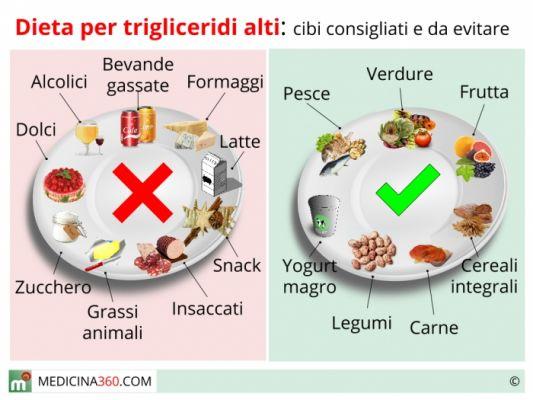
«Triglycerides - Diet for high triglycerides
Diet and Tips for Lowering Triglycerides
Dietary control aimed at regaining or maintaining a healthy weight and reducing triglyceridemia must take into account the following rules:
- follow a balanced diet avoiding excesses.
- Food consumption must be divided into at least three daily meals, possibly including one or two snacks
- Complex carbohydrates are preferred, such as those contained in pasta, whole grains and vegetables, limiting the simple ones present in sweets, sugary drinks and some types of sugary fruit (grapes, bananas, persimmons, figs, etc.). However, it is important not to overdo it even with the intake of complex carbohydrates by calibrating the portions of bread and pasta according to real needs (concept of glycemic index and load).
- Dietary fiber intake will need to be increased or maintained to provide approximately 30 grams of fiber per day. To reach these values it is sufficient to consume at least 4-5 generous portions of fruit and vegetables, possibly associating them with whole foods.
Limit the intake of saturated fats (whole milk and fatty cheeses, sausages, fatty meat, tropical oils) and hydrogenated fats (margarine), preferring monounsaturated ones (olive oil, seeds, dried fruit) but always with some moderation. Eggs can be consumed with some freedom (up to three to four times a week) and will be limited only in case of hypercholesterolemia. - For a patient with high triglycerides it is in some respects more important to limit the intake of simple sugars (sugars) than fat. It should also be considered that often foods rich in high glycemic index carbohydrates such as snacks and sweets also contain high amounts of triglycerides.
- Increase the consumption of fish (at least two or three meals a week), possibly associating it with the integration of polyunsaturated fatty acids. The lipids contained in fish and in particular in salmon, cod and in the species that live in the cold waters of the northern seas, have proved effective in rebalancing the lipid profile of the blood.
- Alcoholic beverages affect plasma triglyceride levels by increasing them. Although modest quantities of wine are tolerated, it is therefore necessary to keep alcohol intake under control.
Physical Activity
A little bit of motion:
it helps to better metabolize the fats and carbohydrates consumed with food (the blood triglycerides of normal weight athletes are usually less than 100 mg / dl)
it removes the risk of diabetes and improves cardiovascular efficiency
promotes weight loss and a sense of well-being by improving the health of the body at 360 °
To obtain these benefits, it is sufficient to follow an aerobic physical activity program (walking, walking, cycling, swimming of duration, etc.) based on at least three weekly sessions with an average duration of not less than 35-40 minutes.
TRIGLYCERIDES AND NUMBERS
2 |
the maximum number of glasses of wine per day (or half a liter of beer, or two small glasses) |
2/3 |
the minimum number of fish-based meals per week |
2/3 |
the minimum number of legume-based meals per week |
3 |
the minimum number of meals per day |
5 g |
the maximum limit of daily intake of hydrogenated vegetable fats |
5 10 |
the minutes of general warm-up that should be done before starting the workout |
10% |
the maximum percentage of daily calories provided by simple sugars |
12 g |
the minimum amount of polyunsaturated fatty acids to take each day |
15-20% |
the total percentage of monounsaturated fatty acids in the diet |
25 |
the level of BMI around which one must remain to be considered normal weight |
30 g |
the ideal intake of fiber per day |
40 |
minutes at least three times a week: ideal amount of physical activity to promote weight loss and control blood triglycerides |
75% |
maximum heart rate: optimal training intensity |
300 mg |
The maximum daily cholesterol intake with the diet |
Before taking the blood sample to measure triglycerides remember to:
- fasting for at least 12-14 hours (the concentration of triglycerides after a meal can increase by up to 5-10 times compared to baseline values). For the same reason, eat a light and balanced meal the evening before the exam.
- Avoid drinking alcohol in the two to three days before the test.
- Avoid overeating for at least 4-5 days before the exam.
- Physical activity should also be limited in the two days preceding the triglyceride test.
Other articles on 'Triglycerides, diet and sport'
- Hypertriglyceridemia - Medicines for the treatment of High Triglycerides
- Triglycerides
- triglyceridemia
- High triglycerides, Hypertriglyceridemia
- Low triglycerides, Hypotiglyceridemia


























